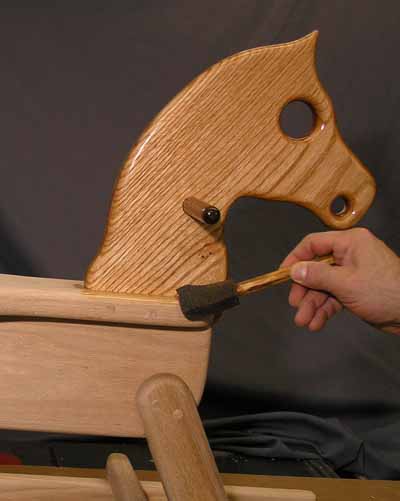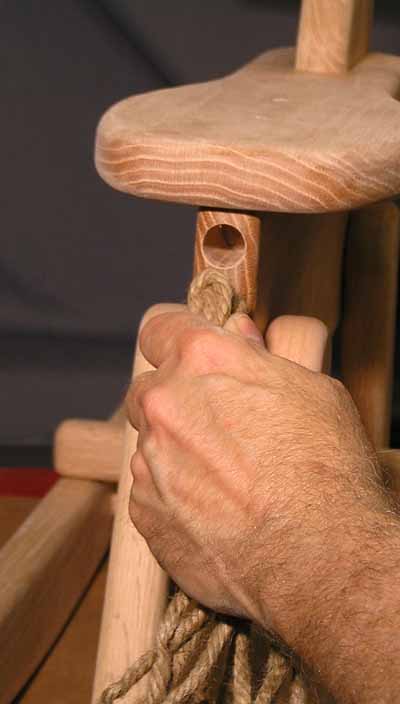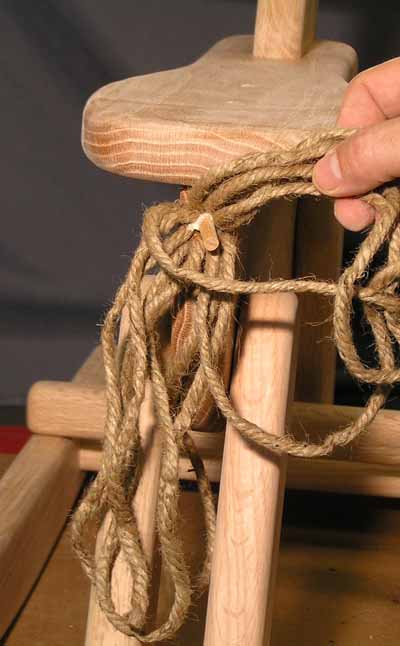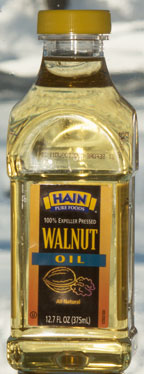Finishes
You can choose from a variety of finishes for your horse or no finish at all. A clear finish will make the horse more soil resistant and bring out the color of the wood. I have never done it, but you could choose a paint if you like.
Clear vegetable oil is my choice as a finish. I use Walnut oil and brush it on quite heavily. Thirty minutes later I wipe off all I can. Don't try to build up layers of oil. They never get very hard and many layers can be gummy. I buy my oil at grocery stores so it is completely nontoxic, even edible. Walnut oil has a long history as a wood finish and is similar to Tung oil, without its toxicity. It is a drying oil and after a few days is completely dry.

If your horse is to be used in a preschool or office I suggest a clear poly-urethane finish. Poly is more work to apply, (sanding between coats) but is both more durable and more protective than oil. You need just such a tough, washable, plastic finish for the hundreds of little hands found in schools or offices. For home use though, I prefer the look and texture of a natural oil. They are easy to apply and need little care. Once a year a little mineral oil renews the luster of the original vegetable oil finish. Once every generation a bit of work with sandpaper will restore the original looks.
When your finish is dry gather about 15 strands of jute fiber together in one hand to make a tail. Add or subtract strands until you have a bundle about 3/4 inch in diameter and 8 to 10 inches long. Use a lot of glue in the tail hole and between the strands before inserting the bundle into the hole. After insertion drive a 1/4 inch diamter dowel into the center of the jute and into the hole to secure it. That's the tail. Trim and fray to suit.


I hope your horse is beautiful and brings your memory to the minds of generations of children.
Method: The interaction of tools, processes, and materials. An honest use of materials, never making the material seem that which it is not, is a good method. Materials and tools must be used optimally, never using one material where another can do the job less expensively and/or more efficiently. The steel beam in a house, painted a fake wood grain; the molded plastic bottle designed to look like expensive blown glass; the 1967 cobbler's bench reproduction dragged into a twentieth-century living room to provide dubious footing for martini glass and ash tray: these are all perversions of materials, tools, and processes.
Design for the Real World - 1972
Victor Papanek

I buy this Hain walnut oil at my grocery store.
Workmanship of the better sort is called, in an honorific way, craftsmanship. Nobody, however, is prepared to say where craftsmanship ends and ordinary manufacture begins. It is a word to start an argument with.
The Nature and Art of Workmanship
David Pye
Sometimes richness of effect is no farther than is obtained by the natural beauty of the wood which is employed; and when this natural beauty is considerable, this simple kinde of furniture is most highly valued.
Hints and Practical Information for Cabinetmakers-1884
John Phin
I
Though all wood is basically similar, every fragment shows the variability found in all natural materials. No two pieces of wood in the world are exactly alike. This gives timber its unique fascination, for no other common durable substance shows patterns and properties peculiar to each piece.
What Wood is That - 1969
Herbert Edlin
Someone's sitting in the shade today because
someone planted a tree a long time ago.
Warren Buffett